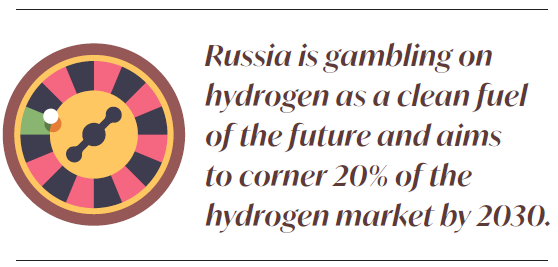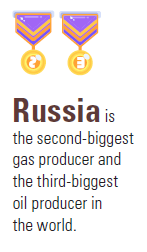Russia starts talking the talk on decarbonisation [Gas in Transition]
The last two years have witnessed a revolution in the approach to decarbonisation of Russia, the world’s fourth largest emitter of greenhouse gases. Much of it is in response to initiatives including the EU’s proposed 2023 Carbon Border Adjustment Mechanism, decarbonisation drives in Russia’s other key export markets including China, which aims to reach net zero by 2060, and attempts by Russian export-oriented businesses to uphold global competitiveness through green technologies and ESG reporting requirements.
A group of UK universities published a paper in November that suggested that Russia could be left with approximately $2 trillion in valueless hydrocarbon assets if major economies hit their own net zero targets. Europe alone imports 45% of Russia’s exports in oil, gas, metals, and fertiliser, meaning that tighter European regulations would damage Russia’s economy considerably.
Another key motivating issue is the environmental situation in Russia: floods, forest fires and black skies are a stark warning sign to the Russian government that will only worsen with time. Signs of desertification are also unsettling the Kremlin, as is the difficulty of maintaining and repairing military facilities that are being challenged by worsening conditions in the Arctic as permafrost melts.
These geopolitical and climate pressures have catalysed an array of changes in the Kremlin’s approach to climate change. One is a more open and committed approach towards tackling climate change; Russian president Putin spoke at COP26 in November about the importance of carbon neutrality by 2060, following on from prime minister Mikhail Mishustin’s announcement of Russia’s 2050 Low Carbon Strategy. But critics question how rhetorical these commitments are.
In October 2021, Mishustin announced an ambitious decarbonisation strategy that would take Russia to carbon neutrality by 2060. The Low Carbon strategy legislation proposes an “intensive” plan whereby Russian emissions grow by only 5% by 2030. The plan envisages a 60% reduction in emissions from its current level by 2050 and a decline in oil and gas exports by 2% annually in real terms from 2030. The strategy includes shifting electric power generation from coal-based power plants to gas turbines, as well as nuclear and renewable power facilities. To meet its targets, the government envisages a strong increase in the absorptive capacity of Russia’s ecosystems, while cutting domestic fuel usage by less than other countries. The ministry of economic development is expected to present an action plan based on the strategy by June 2022.
Much of Russia’s decarbonisation agenda is dependent on carbon capture and storage (CCS). At COP26, Russia signed a deforestation pledge; the country has approximately 20% of global forest cover, so it is no surprise that Putin stated that the preservation of forests and other natural ecosystems will play a decisive role in the fight against global warming with their capacity to absorb greenhouse gases (GHGs). These forests have been troubled in recent years by wildfires that experts attribute to climate change, as well as the endemic issue of illegal logging. Russia has an impressive forestland coverage of nearly 50%, but these climate and logging issues are increasingly detracting from this advantageous position for carbon abatement.
Another Russian goal that was explored at COP26 was advocating for a mechanism of mutual recognition of carbon units, unifying both the international system of calculating carbon units and approaches to establishing a market for them. Given the EU's plans to introduce cross-border carbon regulations, this is a crucial objective for Russia because without achieving it, the country may lose a large part of its export revenues. Additionally, Russian representatives lobbied for “technological neutrality”, meaning the recognition of nuclear power and hydropower as green energies. These energy sources currently account for around 40% of Russia’s electricity production..png)
Hydrogen
Russia is gambling on hydrogen as a clean fuel of the future and aims to corner 20% of the hydrogen market by 2030. As the second largest gas producer in the world, Russia is well placed to use its natural gas as feedstock. In particular, Russia has the potential to become a major producer of blue hydrogen, if it combines its gas reserves with carbon capture technology funding, to clean the process. Its largest gas supplier Gazprom is also researching so-called turquoise hydrogen, which is derived from natural gas using pyrolysis, creating solid carbon that is a valuable commodity in industry. In August 2021, Russia released its Concept for the Development of Hydrogen Energy in Russia, a road map for hydrogen production until 2024. Russia’s official goals are to export 0.2mn metric tons by 2024 and 15-50mn mt by 2050. However, the roadmap is vague, and as such, few details are known about Russia’s intentions regarding hydrogen production funding and hub creation.
A working group aimed at hydrogen development including both large private enterprises and state-owned enterprises (SOEs) was established in July 2021, and some of these stakeholders are already studying plans for hydrogen projects. One example is the blue hydrogen project in Sakhalin, which is being developed by Rosatom. Another example is the blue hydrogen production project on Yamal developed by Novatek, whilst a green hydrogen production project in the Murmansk region is being developed by Rusnano and Enel Russia. Furthermore, in September 2021, Russia signed a bilateral cooperation agreement on hydrogen energy with Japan, closely followed by another deal in November 2021 with the UAE.
Hydrogen hubs
Russia’s hydrogen strategy rests on developing hydrogen hubs. According to its Concept for the Development of Hydrogen Energy in Russia, Russia plans to create three hydrogen hubs – one in the Northwest, one in the East, and one in the Arctic, mirroring potential European and Asian centres of demand (in the Northwest and East respectively) and economic and military interests in the Arctic. The Concept also suggests a fourth Southern hub.
 Whilst the Northwest and East deal with European and Asian markets, the Arctic hub is linked to supply. A Southern hub would necessitate increased growth in demand for hydrogen fuel, but little insight is given in this regard. Little detail is given on exactly where these hubs could be located, but the implication is that the geography of these clusters will mirror the layout of Russia’s natural gas sector.
Whilst the Northwest and East deal with European and Asian markets, the Arctic hub is linked to supply. A Southern hub would necessitate increased growth in demand for hydrogen fuel, but little insight is given in this regard. Little detail is given on exactly where these hubs could be located, but the implication is that the geography of these clusters will mirror the layout of Russia’s natural gas sector.
Russia’s 2035 Energy Strategy envisages a continued expansion of hydrocarbon production, particularly a short-term growth in natural gas exports. The Nord Stream 2 pipeline, which runs under the Baltic Sea to Germany, will allow Russia to export its natural gas volumes quickly to aid its transition away from fossil fuels while enjoying significant influence over Europe’s decarbonisation plans. Europe’s power crunch this autumn following its rapid shutdown of coal and gas fields, heavy EU carbon taxation, and irregular renewable energy generation, have left it more exposed and reliant on Russia’s abundant gas resources. The energy crisis in Europe has also highlighted the vulnerabilities in rushing the decarbonisation process to Russia.
Russia will forge its own path
With Russia’s relations with the West at a low, Russia is not hurrying to join Western-led initiatives and will approach decarbonisation in its own time, continuing to simultaneously expand hydrocarbon production. Indeed, Russia lashed out against US “sermons” regarding Russia’s alleged insufficient efforts to counter the effects of climate change at COP26. Putin did not attend the recent G-20 summit in Rome nor COP26 in person, while Russia, a significant source of methane emissions, often from gas pipeline leaks, refused to join the Global Methane Pledge. More recently, in mid-December, Russia vetoed the UN Security Council Resolution, which positions the climate crisis as a threat to international peace and security. The Kremlin will not roll over to Western prerogatives related to climate change, seeing the issue with the West as one of politicising a chiefly scientific and economic issue.
Russia faces a gargantuan task diversifying away from coal, gas, and oil, even if it has huge potential to expand renewable energy production including solar, hydrogen, biofuels, wind, hydroelectric and geothermal. Large swathes of the country are dependent on oil, gas, and coal extraction to provide jobs and revenue. Autocratic states are unyielding to change and, with Putin looking to stand again for his fifth term in 2024, incentives for bureaucrats to effect dramatic policy changes are few and far between. Vested interests will also put the brakes on the decarbonisation transition, including the powerful coal lobby.
Putin will also be unwilling to give up his leverage over global energy markets, which affords Russia considerable geopolitical influence. Russia is also eyeing geopolitical and economic opportunities in a warming climate, including an increase in agricultural production in the Far East and Siberia and the opening up of access to mineral resources and energy in the Arctic.
However, to avoid stranding its vast assets, Russia will need to ensure that it is making more than token efforts to diversify. The Russian net zero needs to be more than only about how much carbon the country’s forests can absorb, but also radical reductions in emissions. Private businesses need to reduce their most egregious environmental excesses and the government needs to use its hydrocarbon revenues to build green energy infrastructure. The proof of the substance of Russia’s newly-found green declarations will be in what happens, if much at all, between now and COP27, in Sharm El-Sheikh, Egypt, in November 2022.
About the author: Kate Mallinson is managing director of London-based PRISM Political Risk Management and has provided risk management consultancy to multinationals, international financial institutions, lawyers and business risk consultancies for more than 20 years. She has experience managing complex due diligence projects and monitoring political risks across the former Soviet Union, in particular in Central Asia, Russia, Ukraine, Turkey and Iran.



